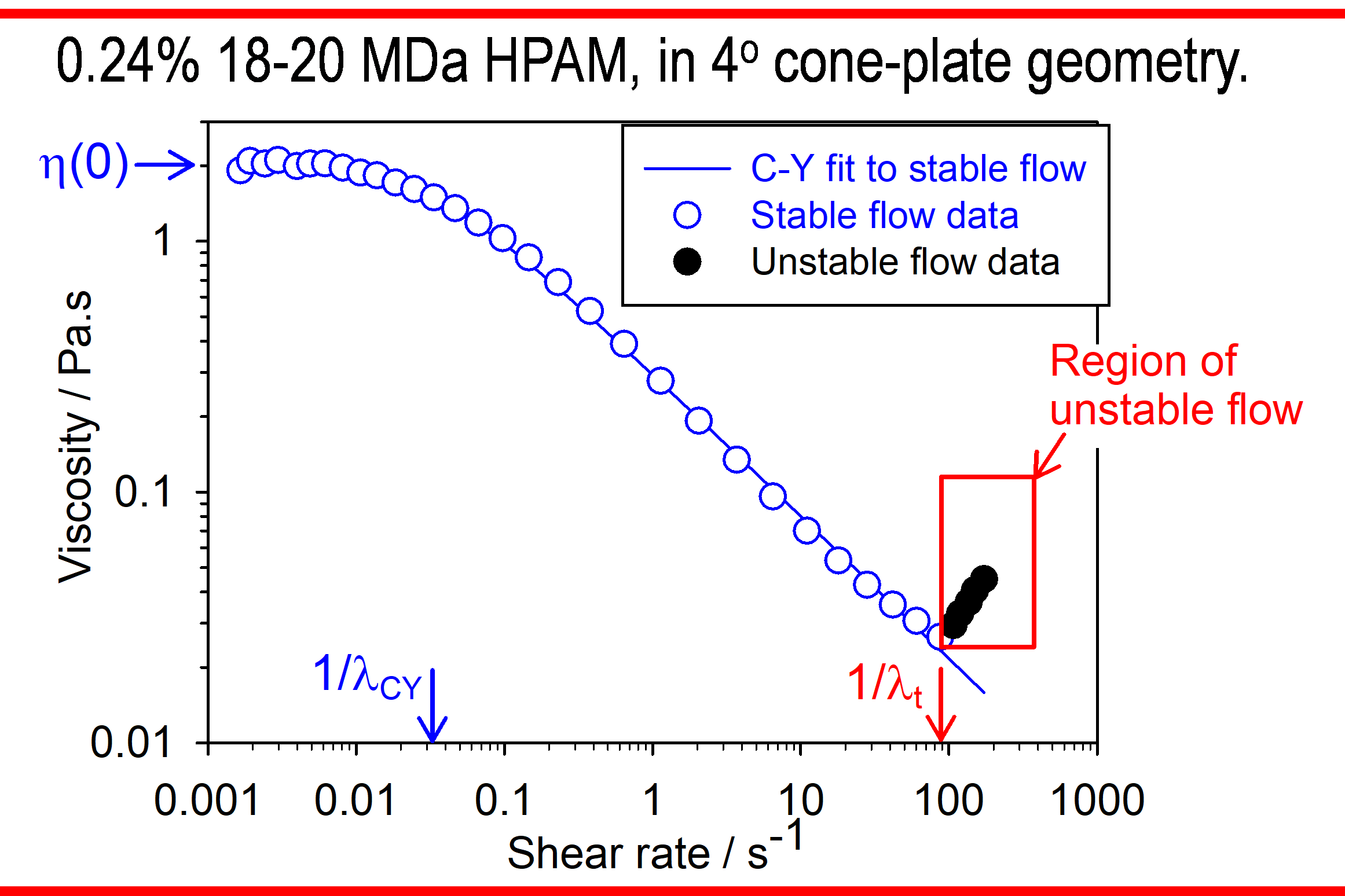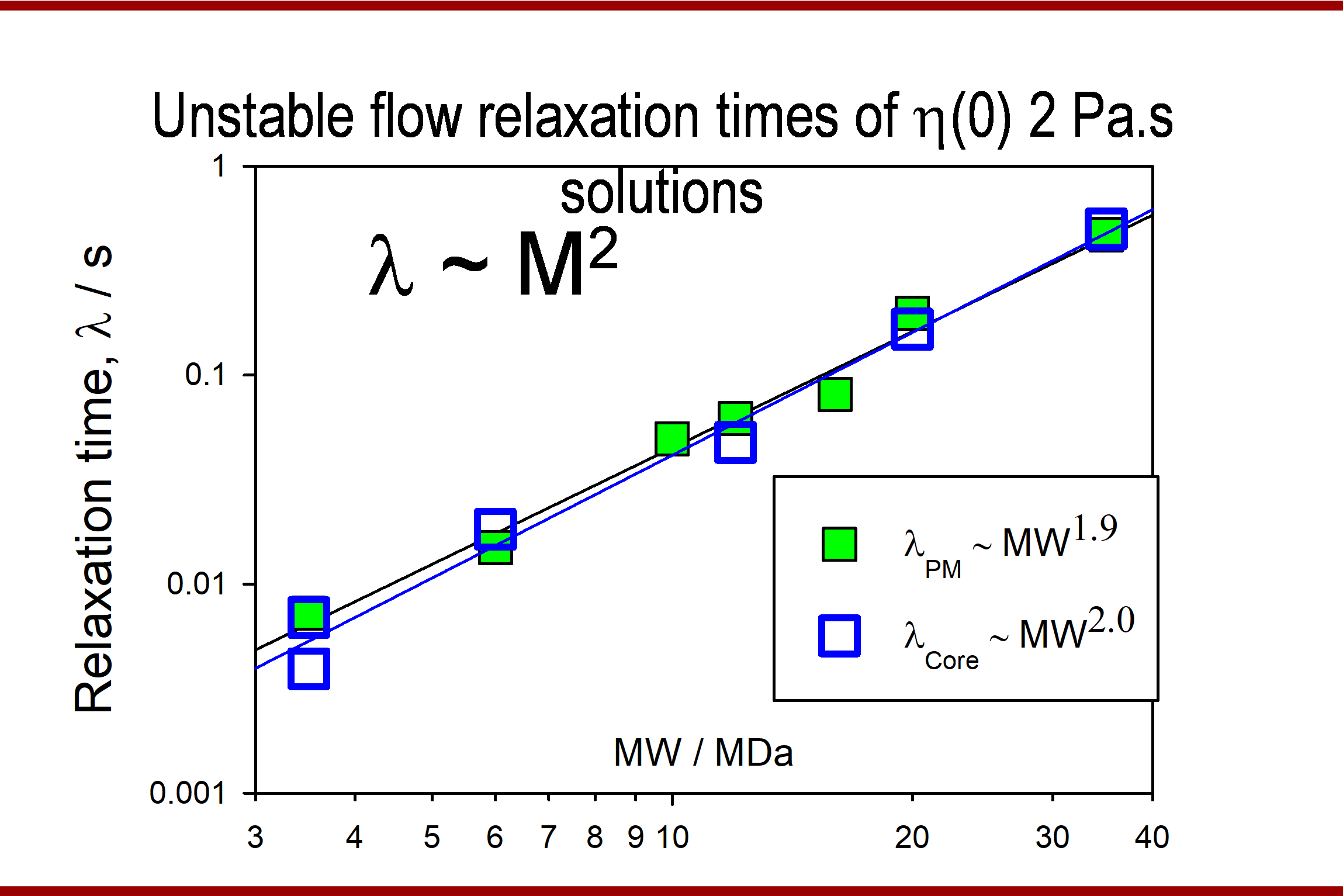
Customer SUCCESS STORY
Supramolecular Chemistry: From Odor Control to Optimizing Oil Recovery: How NETZSCH rheometers can help

A Field Report by Andrew Howe
“I’m Andrew Howe, an industrial colloid/formulation/soft-matter scientist who has enjoyed working with NETZSCH rheometers, and their direct predecessors Malvern and Bohlin, since 1988.
The rheometers prove invaluable in designing materials for maximum efficiency in manufacturing processes and for optimal end-product performance. I used rheometric data when formulating for fast, efficient coating and drying processes at my former employer, Kodak, and for optimising fluid displacement in porous geometries at Schlumberger.
Today I work at Aqdot, a company that originated in the University of Cambridge in 2013. Aqdot is commercialising a supramolecular chemistry technology via cucurbiturils (or “CBs”), macrocyclic molecules that are uniquely effective supramolecular “hosts”. CBs bind non-covalently a wide variety of “guests”, particularly hydrophobic, acidic, basic and cationic moieties.
Much academic work has been carried out on the CB homologues (CB[6], CB[7], and CB[8]) but materials have only been available on the gram scale – even then only at great expense – until now."
Innovative Odor Control on a Large Scale
"Aqdot has scaled manufacturing of CBs to multi-tonne scale and the immediate large-scale market for this material is to remove unpleasant odors and VOCs (Volatile Organic Compounds). The technology enables binding of molecules of a range of different sizes and molecular characteristics.

Aqdot’s approach is to license and supply their product and active markets including home and personal care, textiles and plastics, particularly for automotive applications. A consequence of working across so many markets is that the products need to be included “seamlessly” into many types of formulation, and rheological measurements are an excellent guide to how successful we have been, providing clues as to where we might make adjustments, if required.
Rheology Provides Unique Insights
Whenever there is a “soft” (not-purely solid) formulation to address, the rheometer provides unique insights. One of rheology’s great advantages is that it does not require sample dilution, i.e., materials can be investigated at target concentrations.
Common questions are:
- Will the material flow, will it suspend, is it likely to spray etc.?
- How sensitive is the material to concentration, molecular weight, temperature and Ionic strength?
- Is each batch of product identical?
All these questions are usually amenable to simple rheometric measurements. Rheology results are always directly useful for designing products and optimising performance. The measurements can help narrow choices and speed development as well as troubleshooting problems.
For example, rheometric measurements were of great importance in developing “Oderase”, a water-based, fragrance-free air freshener formulation suitable for use via pump-spray. Carefully chosen rheological experiments helped speed the identification of a composition with suitable properties and stability.
My time in rheology started on joining Kodak. In 1988, we chose a Bohlin VOR rotational rheometer, a deformation-controlled instrument as our workhorse instrument. Since then, controlled-StressStress is defined as a level of force applied on a sample with a well-defined cross section. (Stress = force/area). Samples having a circular or rectangular cross section can be compressed or stretched. Elastic materials like rubber can be stretched up to 5 to 10 times their original length.stress technology has advanced rapidly, so after several versions of the Bohlin CS rheometers (in Kodak then Schlumberger) I was delighted that the Aqdot board approved the purchase of two Kinexus Pro+ rheometers, the successors to the Bohlin instruments.

„Choosing these NETZSCH instruments was an easy decision. The instruments have (and, more importantly, meet!) excellent specifications. NETZSCH scientists and engineers are always very helpful, providing clear solutions to “easy” problems and insightful suggestions to help overcome those more “frontier” or novel challenges.“
The NETZSCH Kinexus Prime Product Portfolio
- Kinexus Prime lab+
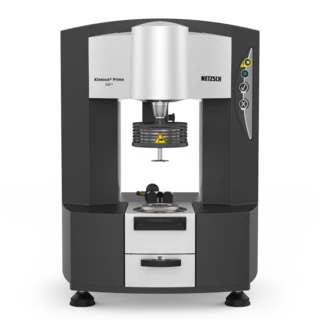
- Kinexus Prime pro+
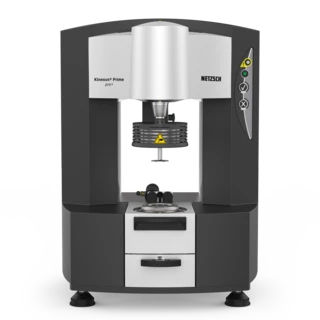
For research and development
- Torque range – viscometry: 5.0 nNm - 225 mNm
- Torque range – oscillation: 1.0 nNm - 225 mNm
- Kinexus Prime ultra+

High-end rheometer for highest demands
- Torque range – viscometry: 1.0 nNm - 250 mNm
- Torque range – oscillation: 0.5 nNm - 250 mNm
Outstanding Service and Customer Support
Choosing these NETZSCH instruments was an easy decision. The instruments have (and, more importantly, meet!) excellent specifications. Also critical is that NETZSCH maintained the outstanding servicing and customer support. NETZSCH scientists and engineers are always very helpful, providing clear solutions to “easy” problems and insightful suggestions to help overcome those more “frontier” or novel challenges.
More recently, webinars have provided good insights and direct help more broadly to users, not only answering common questions, but perhaps pointing out opportunities for new ways in which instruments many be deployed.
I was delighted with the recent seminar on rheology artefacts: an understanding of artefacts is essential to making the best possible measurements and for being able to describe, with confidence, results to others.
Polymer Enhanced Oil Recovery: The Unusual Flow Behaviour of Aqueous Solutions of Very High Molecular Weight Polymers
Typical day-to-day measurements involve both continuous (flow curves) and oscillatory shear (frequency and StressStress is defined as a level of force applied on a sample with a well-defined cross section. (Stress = force/area). Samples having a circular or rectangular cross section can be compressed or stretched. Elastic materials like rubber can be stretched up to 5 to 10 times their original length.stress sweeps). Working in industry means that the majority of measurements cannot be disclosed. However, with Andrew Clarke and colleagues at Schlumberger we published a series of papers on unusual flow behaviour of aqueous solutions of very high MW polymers in porous media, with the application being recovery of crude oil.[1]
Our work followed the previously noted phenomenon that with fluids containing extremely high MW (>15 MDa) flexible polymers, back pressures increased beyond those consistent with shear viscosity above a critical flow rate: that critical rate was accessible in oilfield flow conditions. We confirmed that the critical rate was independent of polymer concentration but decreased with the square of the polymer MW. Such dependencies are very unexpected. Microfluidic studies indicated the flow became unstable above this critical flow rate. We were able to replicate the flow-instability in simple shear flow, as demonstrated in Figure 1 for very high MW (18-20 MDa) partially hydrolysed poly(acrylamide). At low rates, conventional behaviour (Newtonian power-law thinning) is apparent which can be fitted with a Carreau-Yasuda model, giving a RelaxationWhen a constant strain is applied to a rubber compound, the force necessary to maintain that strain is not constant but decreases with time; this behavior is known as stress relaxation. The process responsible for stress relaxation can be physical or chemical, and under normal conditions, both will occur at the same time. relaxation time lCY. However, there is an apparent thickening from 100s-1 which, at first, seems surprising.
This shorter RelaxationWhen a constant strain is applied to a rubber compound, the force necessary to maintain that strain is not constant but decreases with time; this behavior is known as stress relaxation. The process responsible for stress relaxation can be physical or chemical, and under normal conditions, both will occur at the same time. relaxation time lt increases (onset rate decreases) with the square of the polymer MW, which is the same as seen on flow of these fluids through rock cores (Figure 2).
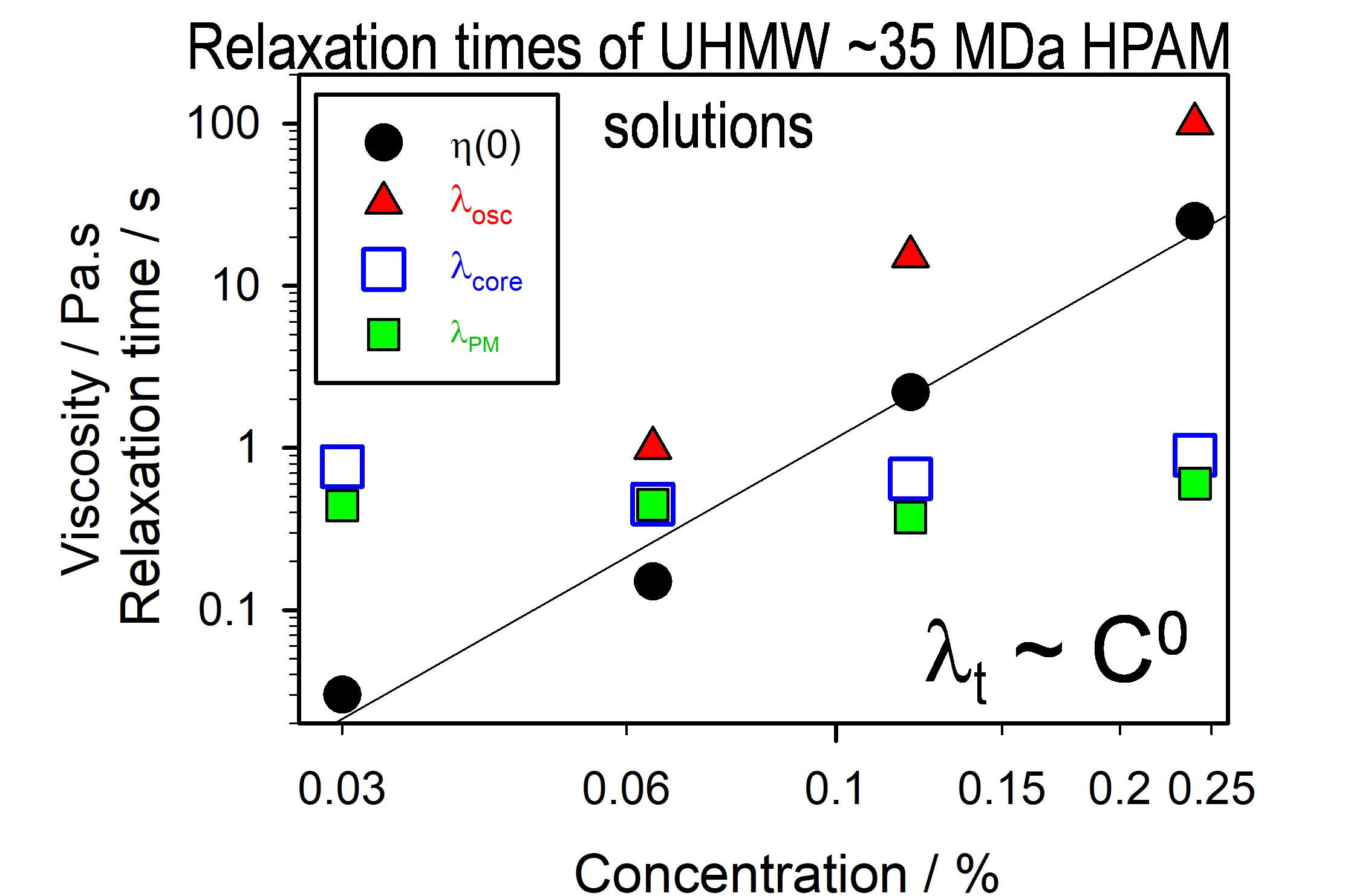
The zero-shear viscosity h(0), the RelaxationWhen a constant strain is applied to a rubber compound, the force necessary to maintain that strain is not constant but decreases with time; this behavior is known as stress relaxation. The process responsible for stress relaxation can be physical or chemical, and under normal conditions, both will occur at the same time. relaxation times for the onset of thinning lCY and the G’=G” crossover (losc) each increase with polymer concentration C3 while the onset of thickening at high shear (rescaled as lPM) and in the rock (lcore) are independent of concentration (Figure 3).
The thickening corresponds to a transition to unstable flow: in “steady state” step-StressStress is defined as a level of force applied on a sample with a well-defined cross section. (Stress = force/area). Samples having a circular or rectangular cross section can be compressed or stretched. Elastic materials like rubber can be stretched up to 5 to 10 times their original length.stress measurements there is a hysteresis in apparent viscosity value while in StressStress is defined as a level of force applied on a sample with a well-defined cross section. (Stress = force/area). Samples having a circular or rectangular cross section can be compressed or stretched. Elastic materials like rubber can be stretched up to 5 to 10 times their original length.stress-ramp (0.3 s at each StressStress is defined as a level of force applied on a sample with a well-defined cross section. (Stress = force/area). Samples having a circular or rectangular cross section can be compressed or stretched. Elastic materials like rubber can be stretched up to 5 to 10 times their original length.stress value) the flow is unsteady with fluctuating values of “instantaneous” viscosity (Figure 4).
The transition to unstable flow is consistent with “elastic turbulence”[2], a phenomenon associated with very high MW polymers flowing in curved streamlines: porous media such as rocks have highly curved structures, rheometric geometries much less so. However, even the low levels of curvature in a cone-plate geometry are sufficient to generate unstable flow by this mechanism.[3]
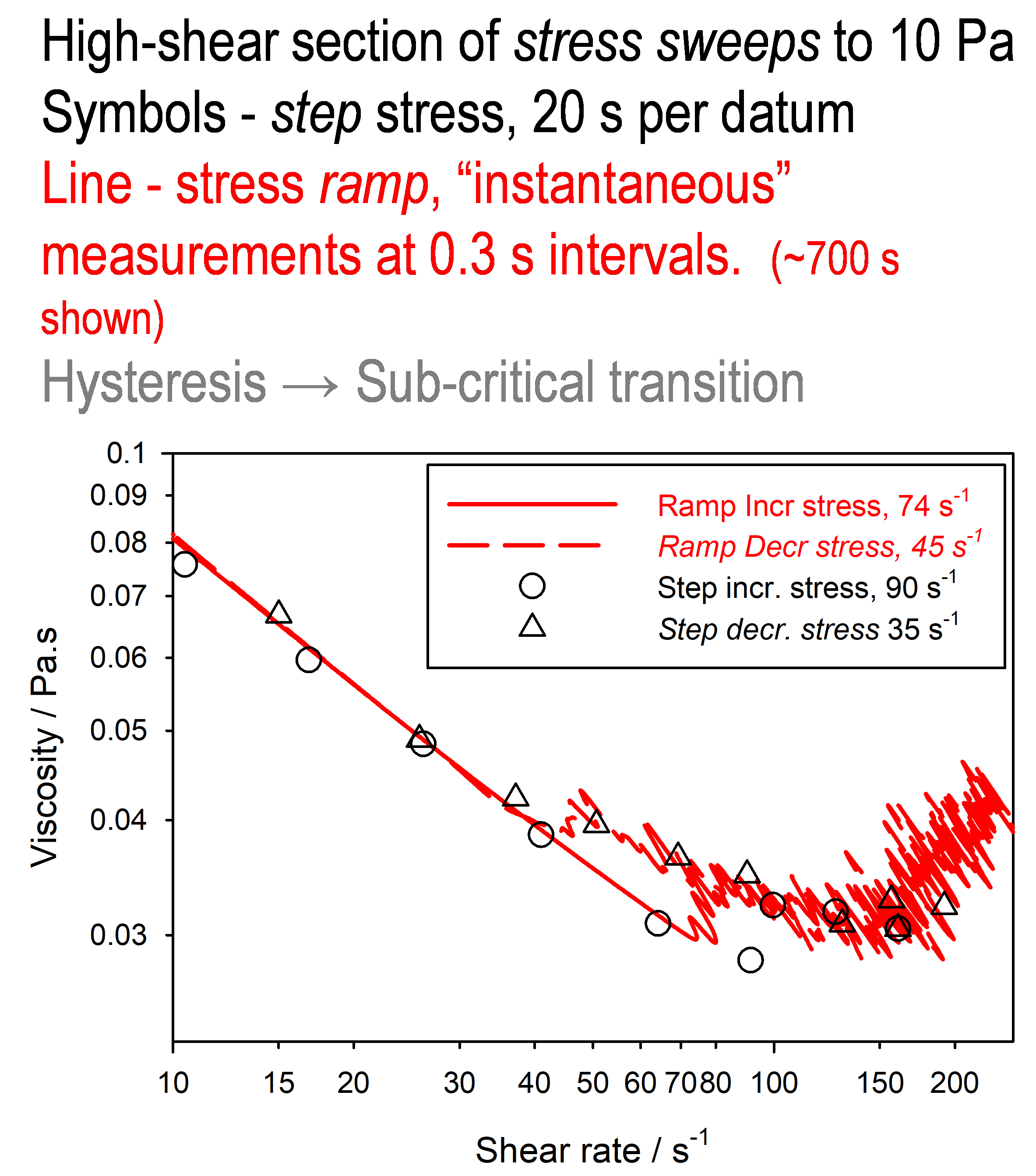
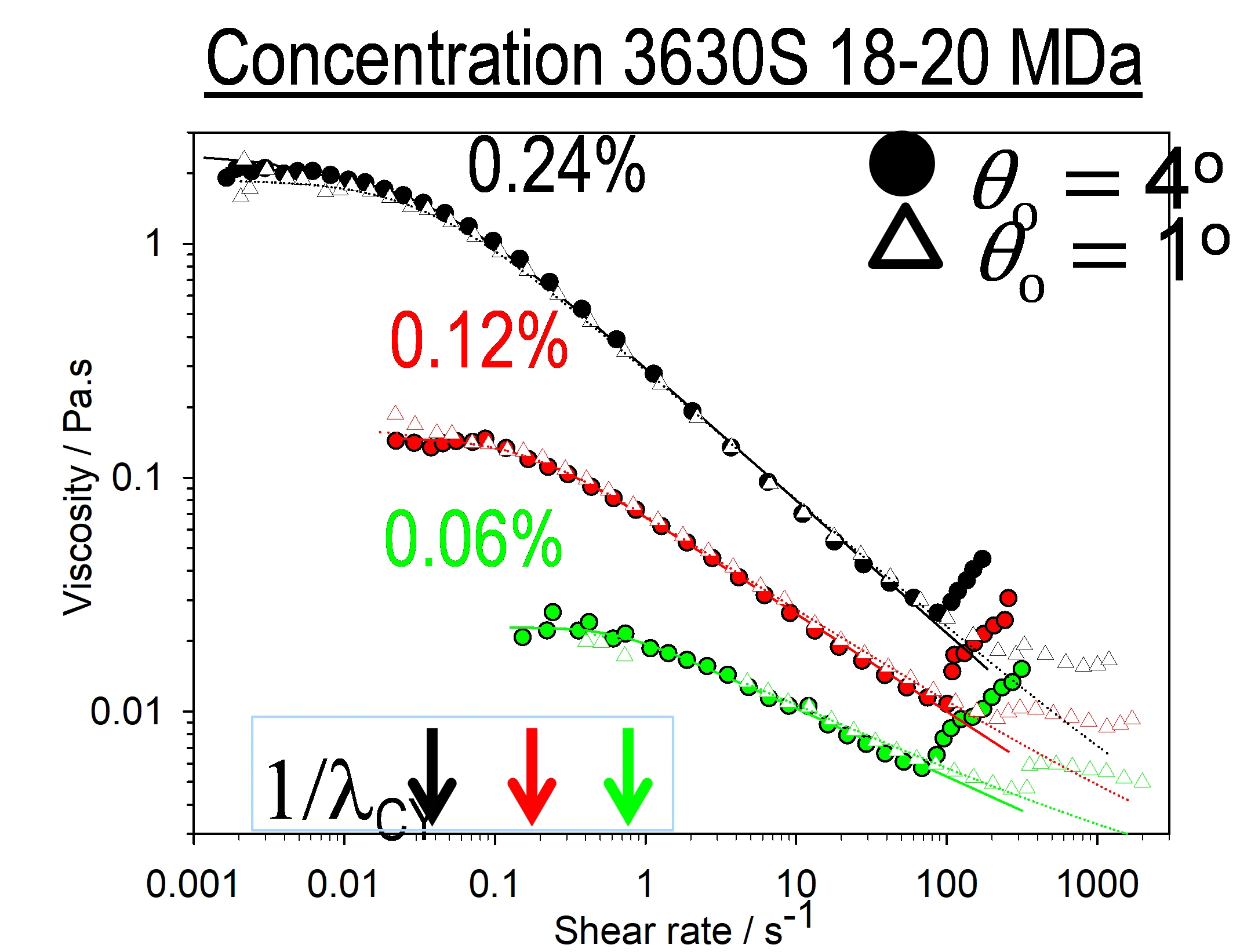
Experiments with 1o and 4o cones yielded the expected overlapping data at low shear but the thickening/unstable flow at high rates starts at lower rates with the larger-angle cone.
This behaviour is very different from the secondary flows (Turian vortices) that onset at higher rate on increasing viscosity: for these polymers, the onset of unstable flow depends on the MW, the rate and the cone angle but not the viscosity.
Conclusion
Before this work, understanding of polymer enhanced oil recovery was based on simple viscoelastic behaviour in porous media. These studies demonstrated that equilibrium flow is not an appropriate description of local behaviour: in elastic turbulence the flow field fluctuates strongly around the mean in terms of both direction and magnitude, and consequently is significantly more effective in displacing a trapped high-viscosity fluid such as crude oil than would be expected.
These data led to a predictive understanding of why and under what conditions very high MW polymers displace more oil than predicted from their linear viscoelastic behaviour. The role of rheometric measurements with high-quality rheometers was crucial in the generation of this understanding.
Acknowledgement:
As has often been the case, discussions with Adrian Hill and Shona Marsh (UK customer support) helped in guiding the optimal experimental conditions for the ramp/step StressStress is defined as a level of force applied on a sample with a well-defined cross section. (Stress = force/area). Samples having a circular or rectangular cross section can be compressed or stretched. Elastic materials like rubber can be stretched up to 5 to 10 times their original length.stress studies! And Darren Tennant kept the rheometers in tip-top condition.”
Andrew, thank you very much for these interesting insights in your research work and for the trust you have given into NETZSCH and our rheometers for decades!
[1] Mechanism of anomalously increased oil displacement with aqueous viscoelastic polymer solutions, A Clarke, A M Howe, J Mitchell, J Staniland, L Hawkes, K Leeper, Soft Matter, 2015, 11, 3536 – 3541.Viscoelastic Flow of concentrated viscoelastic polymer solutions in porous media. Effect of MW molecular weight and concentration on elastic turbulence onset in various geometries. A M Howe, A Clarke and D Giernalczyk, Soft Matter, (2015) 11 6419 - 6431.
Real-time oil-saturation monitoring in rock cores with low-field NMR J Mitchell A M Howe, A Clarke Journal of Magnetic Resonance, (2015) 256, 34–42
Polymer Flows and Elastic Turbulence in Three-Dimensional Porous Structures, J Mitchell, K Lyons, A M Howe and A Clarke, Soft Matter, 2016,12, 460-468.
How Viscoelastic Polymer Flooding Enhances Displacement Efficiency, A Clarke, A M Howe, J Mitchell, J Staniland, L A Hawkes; SPE Journal, SPE-174654-MS, SPE Journal SPE J. 21 (03): 0675–0687.
[2] Elastic turbulence in a polymer solution flow A Groisman and V Steinberg, Nature 405, 53 (2000).
Efficient mixing at low Reynolds numbers using polymer additives A Groisman and V Steinberg, Nature 410, 905 (2001).
[3] Elastic instability and curved streamlines P Pakdel and G H McKinley, Physical Review Letters, 77, 2459, 1996.
